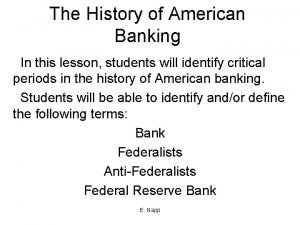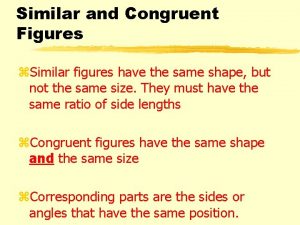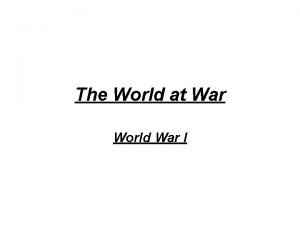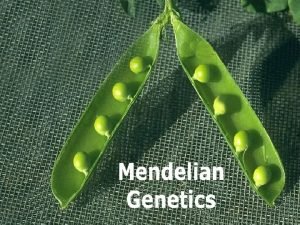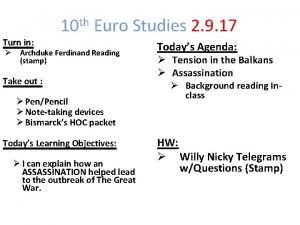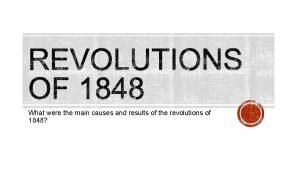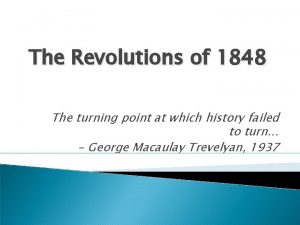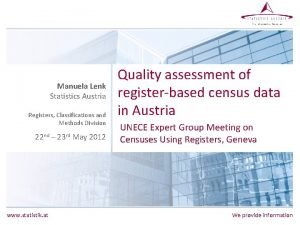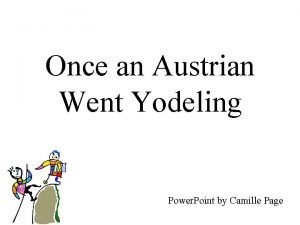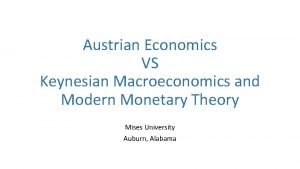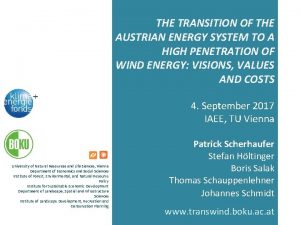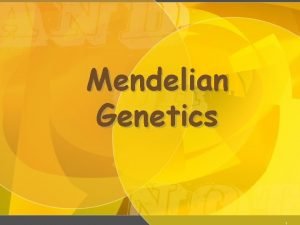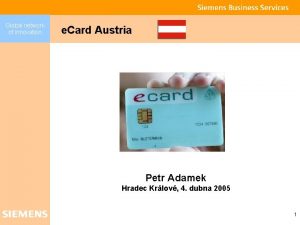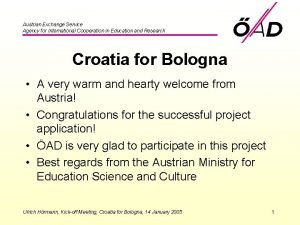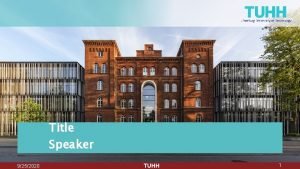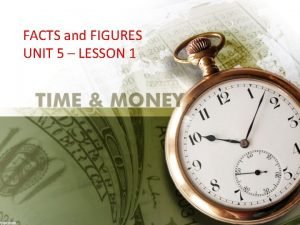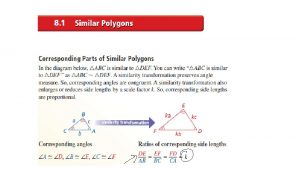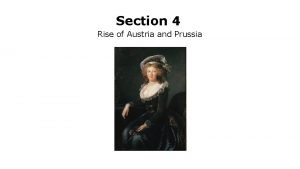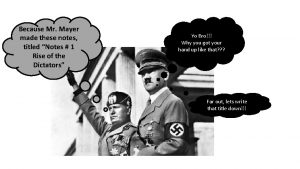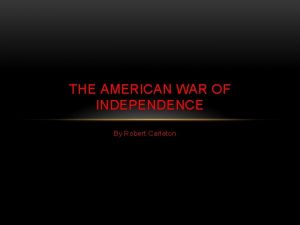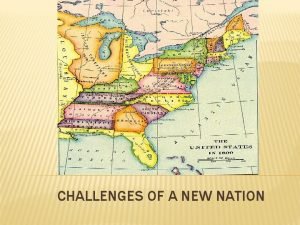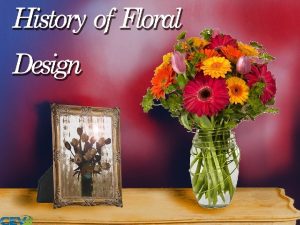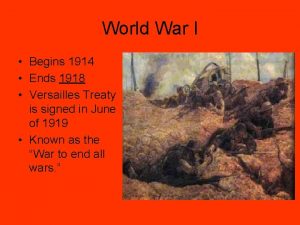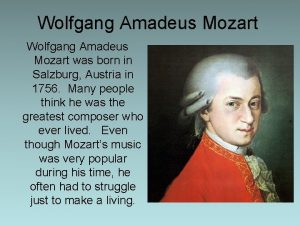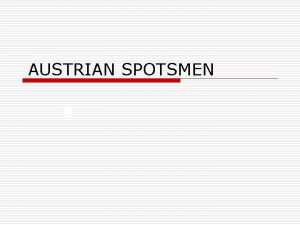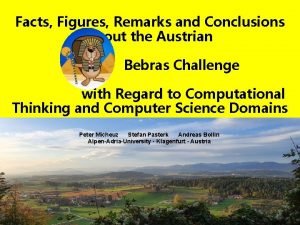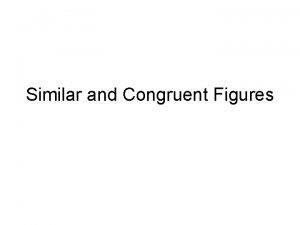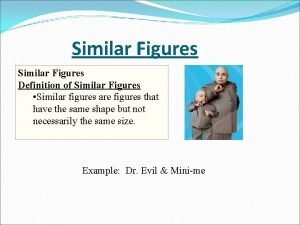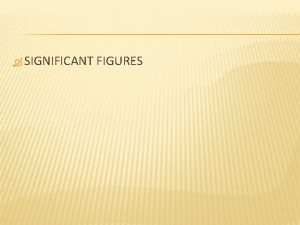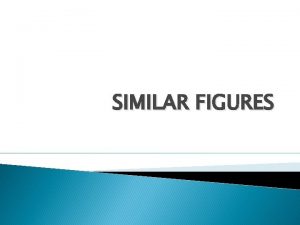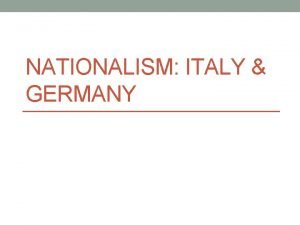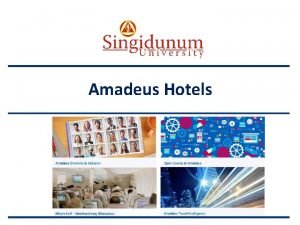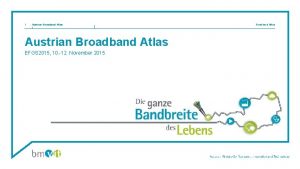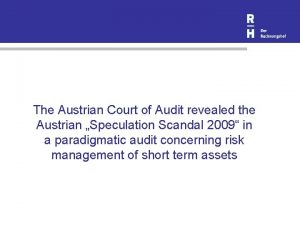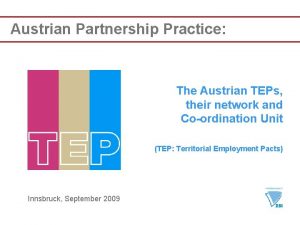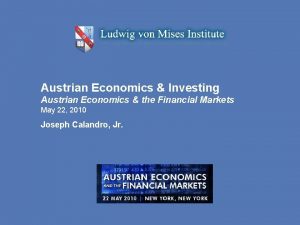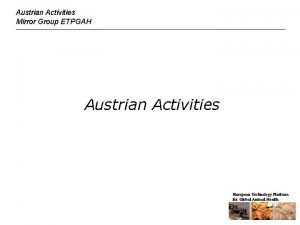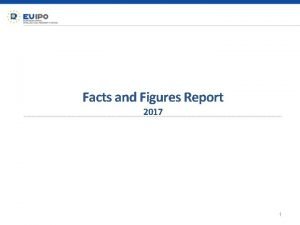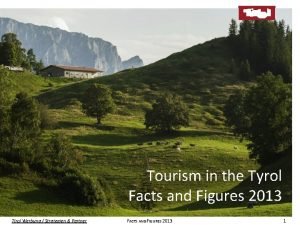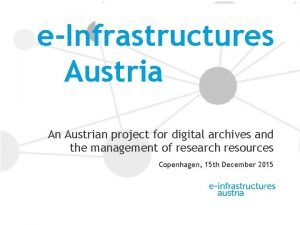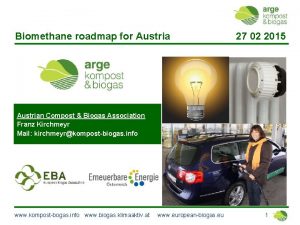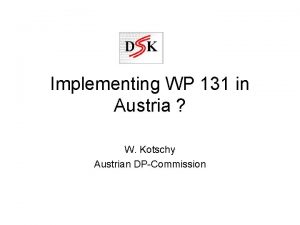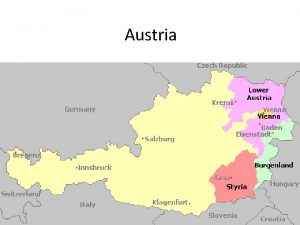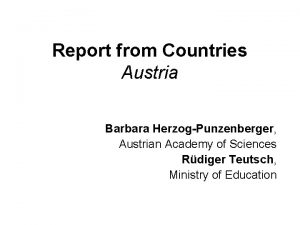Austria Today History Facts and Figures Austrian American










































- Slides: 42

Austria Today History, Facts and Figures Austrian – American Relations

Located in the Heart of Europe Population: 8, 199, 783 (2007) GDP growth: 3. 2% (2007) Area: 32, 382 sq miles GDP: € 31, 400 (2007) Land boundaries: 1, 682 miles Inflation: 2. 3 % (2007) 98% of Austria‘s population is German speaking

Sharing Borders with Neighboring Countries Germany 509 miles Czech Republic 291 miles Ital 267 miles y Hungary 220 miles Slovenia 205 miles Switzerland 64 miles 104 miles Slovaki a Liechtenstein 22 miles Total (8) countries 1, 682 miles

The history of Austria …. goes back many centuries. The name “Austria” was mentioned for the first time in a record in 996 A. D. Stamp commemorating Austria’s 1000 th birthday First mention of “Ostarrichi”

Habsburg Monarchy Under the rule of the Habsburgs, Austria witnessed its greatest expansion, and formed close dynastical alliances with many of Europe's royal houses, enabling Vienna to shape and determine Europe's history for centuries. The Congress of Vienna, 1815 – peace conference upon conclusion of the Napoleonic Wars Austro-Hungarian Empire under Franz Joseph I in 1914

World War I (1914 -1918) After the end of World War I, Europe's geographical landscape changed significantly. The Austro-Hungarian Empire ceased to exist, leaving behind the formation of new countries. The German-speaking parts of Austria formed the successor state, the Republic of Austria 1919/20

World War II (1939 -1945) Following the experiences of two devastating world wars involving millions of victims of armed conflict, persecution, genocide and the Holocaust, the foundation for a new world order and world peace was created in the form of the United Nations Organization in 1945. World War II United Nations, New York

The Marshall Plan: U. S. Financial Assistance for European Reconstruction Under the Marshall Plan, the U. S. provided significant financial assistance for European reconstruction (5% of the U. S. federal budget flowed into the European Recovery Program, whereby Austria received a total amount of one billion dollars in aid over several years). UK US F USS R 1945 -1955: Austria was divided into four zones of postwar administration

Austrian State Treaty 1955 Declaration of the State Treaty, May 15, 1955, Upper Belvedere Palace With the signing of the Austrian State Treaty, Austria was guaranteed independence by the Allied Powers – the U. S. , Great Britain, France and the Soviet Union. Austria declared at the same time its continued neutrality.

The Cold War: Austria as a Hub Between East & West In the years following Austria, being a neutral country centrally located between the East and the West blocs, hosted a number of historic summit meetings and high-level international conferences. John F. Kennedy with Nikita Khrushchev, June 1961: Vienna

Austria: An Active Member of the UN Since joining the United Nations in 1955, the newly independent Austria took part in numerous UN peace keeping missions in the world. In 1980 the UN headquarters building in Vienna was inaugurated, housing several UN Organizations such as the International Atomic Energy Agency (IAEA) or the United Nations Industrial Development Organization (UNIDO). United Nations Headquarters in Vienna Austria’s participation in UN missions

Humanitarian Aid and Asylum In the past fifty-some years Austria has offered generous aid and asylum to refugees, some of whom have found a new home in Austria, or new homes in other parts of the world via Austria. - Hungarian Revolution in 1956 - Prague Spring 1968 - Emigration of Soviet Jews to Israel via Austria - Conflict in former Yugoslavia in Hungarian refugees in 1956 Austrian humanitarian initiative for the Balkans

A Member of the European Union • In 1995 Austria joined the European flag The EURO The European Parliament in Union. • In 2002 the EURO was introduced as the common European currency. • While assuming the Presidency of the European Union in 1998 and 2006, Austria chaired numerous summit, ministerial and expert meetings on a broad range of issues and was significantly involved with the development of the European Union and its policies.

A Gateway to Central and Eastern Europe The fall of the Iron Curtain provided new opportunities for Europe and Austria. With traditionally close ties to its neighboring countries Austria is an evermore important trading partner and investor in the emerging economies of Central and Eastern Europe. More than 300 international companies have their CEE headquarters in Austria

Political System Austria is a Federal Republic The Parliament in Vienna Austria’s head of state: Federal President Dr. Heinz Fischer Austria’s head of government: Federal Chancellor Dr. Alfred Gusenbauer

Tourism – Optimal Amenities - Accessibility through air and ground transportation - High environmental and safety standards - Excellent infrastructure - Diverse scenery and cultural attractions …make Austria a wonderful and exciting destination for tourists. The World Economic Forum in Davos ranked Austria as the 2 nd most attractive tourist country in the world.

Culture Today Austria‘s cultural heritage and treasures are well known and admired all over the world: Vienna Philharmonic Orchestra -Celebrating Vienna New Year‘s Concert -Considered one of the finest in the world Vienna Boys’ Choir A choir of boy sopranos and altos based in Vienna

Vienna Opera Ball Annual Austrian society event which takes place in the Vienna State Opera Salzburg Festival Prominent festival of music and drama Spanish Riding School Oldest and last Riding School in the world

Sports The most popular sport is alpine skiing Similar sports as skijumping or snowboarding are also very popular The Grossglockner, Austria’s highest mountain (3, 798 m) 12, 461 ft Hermann Maier: 2 Olympic gold medals (both in 1998) Franz Klammer: 2 Olympic gold medals (1974 and 1976) Skiing in Austria

Sports Most popular team sport is soccer 2008 UEFA European Football Championship takes place in Austria and Switzerland 1964 and 1976 Olympic Winter Games in Innsbruck

Austrian Cuisine Vienna Coffeehouses Wiener Schnitzel …famous for its pastries Coffee in Vienna Sachertorte Apfelstrudel Café Central Austrian Wine

Austrian Scientists Sigmund Freud (1856 -1939) Founder of the psychoanalytic school of psychology. Ferdinand Porsche (1875 -1951) Automotive engineer, designed the original Volkswagen Beetle. Many Austrian scientists and Nobel Prize winners have won recognition far beyond the borders of their native country Joseph Alois Schumpeter (1883 -1950) Economist, developed theory of business cycles and development. Business Cycle VW Beetle

Austrian Art and Music: From the Classical to the Modern Era Joseph Haydn (1732 -1809) Wolfgang A. Mozart (1756 -1791) Franz Schubert (1797 -1828) Johann Strauss (1804 -1849) Gustav Mahler (1860 -1911) Arnold Schönberg (1874 -1951) Works of art by Otto Wagner (1841 -1918) Gustav Klimt (1862 -1918) Oskar Kokoschka (1886 -1980) Egon Schiele (1890 -1918)

Austria and the United States

U. S. : Austria‘s Third Biggest Trading Partner - Exports 2006: 6. 2 billion EUR (+15. 5%) - Imports 2006: 3. 2 billion EUR (+11. 3%) - Increased export of all major types of goods Automotive / Energy Drinks / Pharmaceuticals / Machinery / Seamless Pipes / Sheet Metal / etc. - U. S. is 3 rd most important trade partner after Germany and Italy Red Bull Automotive parts, industrial goods Austrian wine and food

EU-U. S. Transatlantic Partnership The Transatlantic Dialogue between the E U and the U. S. established in 1995 provides regular summit and ministerial meetings as well as meetings of experts on a broad range of economic and political issues. The U. S. is the EU’s most important trading partner: • EU-U. S. trade exchange amounts to over $1 billion per day • Approx. 14 million jobs are closely linked to transatlantic economic EU-US Summit Meeting in Vienna, Austrian cooperation and trade. Chancellor Schüssel and • The EU is the biggest investor in the U. S. President Bush (2006)

Austrian Centers in the U. S. Close cooperation between universities in the U. S. and sister institutions in Vienna and Innsbruck have resulted in successful student exchange programs and summer schools. The Centers for Austrian Studies at the University of Minnesota and the University of New Orleans have strongly promoted this vibrant exchange.

Wolfgang Puck: Photo courtesy Academy of Motion Pictures Arts and Sciences Austrians in the U. S. Throughout the United States you will find Americans of Austrian descent. Among those Austrians living in the United States today, several play a prominent role in the areas of culture, science, as well as in politics and sports. Governor and former actor Arnold Schwarzenegger Celebrity chef Wolfgang Puck Ice hockey player Thomas Vanek

Sound of Music Most Americans are familiar with the beautiful melodies of the musical featuring the story of the Trapp family. The musical and movie have won several awards and the musical has been performed over 1, 500 times on Broadway. Schloß Leopoldskron, Salzburg – site of the famous movie Trapp Family Lodge, Vermont













… see you in Austria
 Lesson 2: the history of american banking and banking today
Lesson 2: the history of american banking and banking today Two shapes that are similar are also congruent
Two shapes that are similar are also congruent Plane shape
Plane shape Plane figures and solid figures
Plane figures and solid figures For today's meeting
For today's meeting Today's class was amazing
Today's class was amazing Proposal kickoff meeting agenda
Proposal kickoff meeting agenda Fingerprint ridge characteristics worksheet
Fingerprint ridge characteristics worksheet Today's lesson or today lesson
Today's lesson or today lesson Example of repitition
Example of repitition Austrian succession
Austrian succession Austrian ultimatum to serbia
Austrian ultimatum to serbia ____________is the austrian monk who experimented with
____________is the austrian monk who experimented with Austrian ultimatum to serbia
Austrian ultimatum to serbia Austrian empire 1848
Austrian empire 1848 Austrian empire 1848
Austrian empire 1848 Manuela lenk
Manuela lenk An austrian went yodeling
An austrian went yodeling Austrian genetic traits
Austrian genetic traits Mendel
Mendel Austrian-serbian
Austrian-serbian Austrian economics vs keynesian
Austrian economics vs keynesian Patrick scherhaufer
Patrick scherhaufer Gregor mendel austrian monk
Gregor mendel austrian monk E-card austria
E-card austria Austrian academic exchange service
Austrian academic exchange service Raw facts and figures
Raw facts and figures Facts & figures linda lee
Facts & figures linda lee Facts & figures linda lee
Facts & figures linda lee Fair trade facts and figures
Fair trade facts and figures Tuhh environmental engineering
Tuhh environmental engineering Facts and figures slide
Facts and figures slide Similar figures worksheet
Similar figures worksheet Multiplication facts and division facts
Multiplication facts and division facts Rise of austria and prussia
Rise of austria and prussia Germany and austria join in the anschluss
Germany and austria join in the anschluss Mona lisa facts and history
Mona lisa facts and history Leslie appelgate
Leslie appelgate American revolution facts
American revolution facts Native american important facts
Native american important facts Flemish floral design
Flemish floral design Was austria hungary a country
Was austria hungary a country Mozart was born in salzburg 1756
Mozart was born in salzburg 1756
